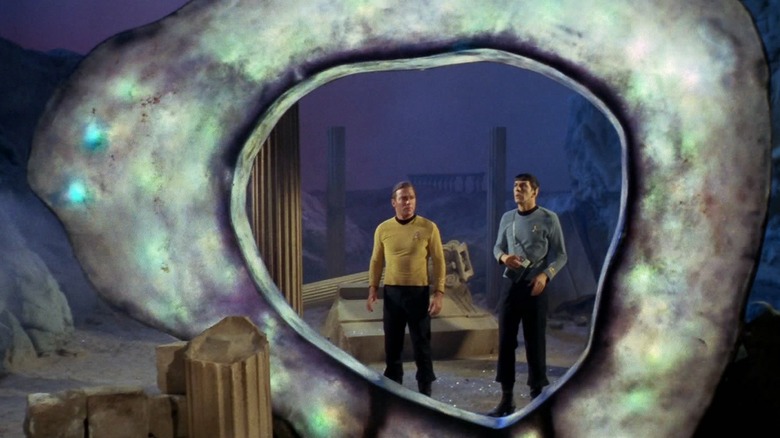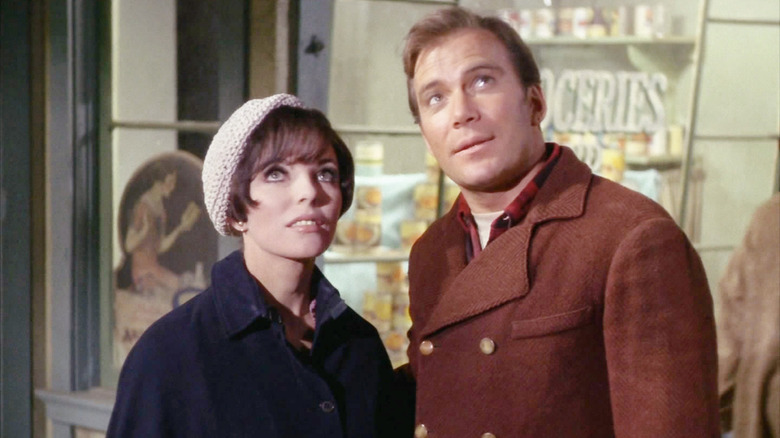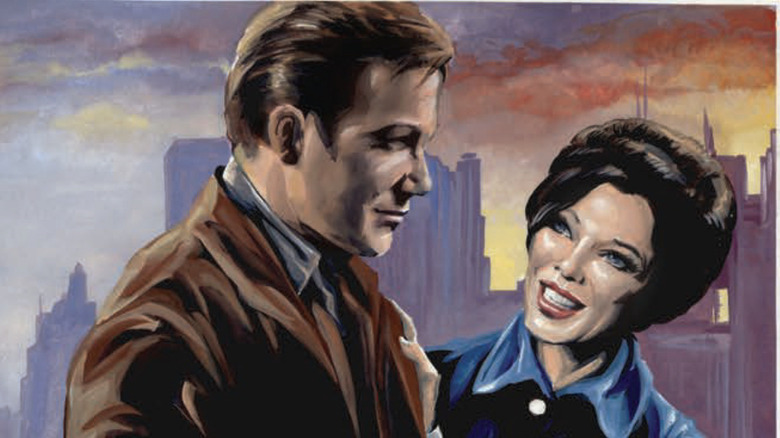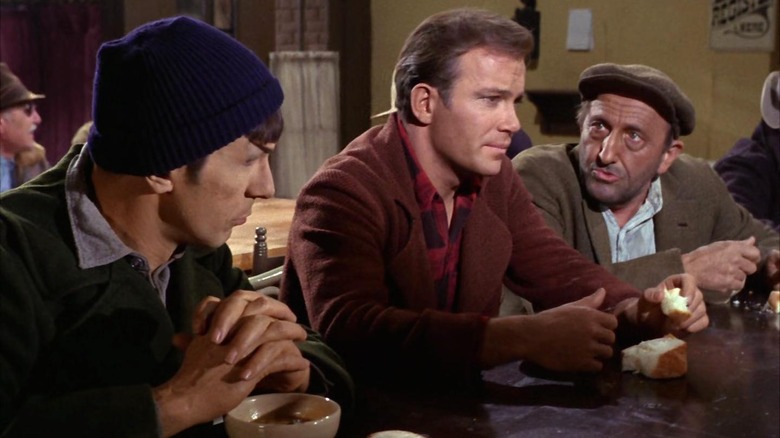Star Trek's Best Original Series Episode Was Also One Of The Hardest To Produce
What's the best "Star Trek" episode? Of the 79 produced in "The Original Series," the most highly-regarded is often season 1, episode 28, "The City on the Edge of Forever." We at /Film named it as the best "Star Trek" episode and we're not alone.
Here's the premise; the Enterprise is exploring a planet home to the Guardian of Forever, essentially a sentient time portal. Dr. McCoy (DeForest Kelley) is accidentally injected with the fictional drug Cordrazine and leaps through the portal, disrupting the timeline and the main characters' present. So, Kirk (William Shatner) and Spock (Leonard Nimoy) follow McCoy, winding up in New York City during the Great Depression.
There, they meet Edith Keeler (Joan Collins, a soon-to-be legend who, like some other "Star Trek" actors, is still with us). Keeler is an idealistic woman who runs a soup kitchen and preaches pacificism; Kirk falls in love with her. Unfortunately, Spock discovers that unless Miss Keeler dies, she'll grow to become an influential activist who delays U.S. entry into World War 2, resulting in a Nazi victory when they split the atom before J. Robert Oppenheimer does. McCoy altered the timeline by pushing Keeler out of a car's path, so a reluctant and heartbroken Kirk holds Bones back and lets her be hit by a car and die.
"The City on the Edge of Forever" is the bar all subsequent "Star Trek" time travel stories have been reaching for, from the theatrical movie "Star Trek IV: The Voyage Home" to "Tomorrow and Tomorrow and Tomorrow" in "Strange New Worlds" season 2 (featuring a younger Kirk played by Paul Wesley).
While the stakes the writers faced weren't quite as high as saving the world, the production of "The City on the Edge of Forever" hit a number of roadblocks. And yet, it persevered through to excellence.
Writing one of the first Star Trek scripts
"The City on the Edge of Forever" was written by the late Harlan Ellison, a legendary (and legendarily abrasive) sci-fi writer (just look at Ellison's work still being homaged on "Star Trek: Lower Decks"). However, the script went through many revisions that left Ellison dissatisfied; he's the only credited writer on the episode, but the finished episode wasn't made to his vision.
Keep in mind that there have been many behind-the-scenes retellings of "Star Trek" production history over the years, with the primary sources being the fading memories of men with big egos. That said, the 1991 book "Inside Star Trek: The Real Story" by Robert Justman (a producer on "Star Trek") and Herbert Solow (who was "Executive In Charge of Production" on "Star Trek") tells the behind-the-scenes story like this.
Ellison pitched the episode on March 3, 1966. He then submitted a first draft, dated June 3, and later a final draft, dated August 15. Story Editor Steve Carabatso revised the script, poorly (this rewrite was even deemed unacceptable for filming), so Ellison submitted another revision, dated December 1, 1966 (but received on December 19).
However, the tug of war didn't stop. The Mission Log Podcast uncovered Justman's notes on Ellison's December draft of "The City on the Edge of Forever" (dated December 20, 1966), submitted to "Star Trek" creator Gene Roddenberry. Justman's notes concern both logistics (such as Ellison's excessive description) and the episode's narrative/continuity within the larger series. He writes in his conclusion:
"I still feel that this is a fine story and was created by an extremely talented writer. But we are in the sad position of being unfortunate enough not to be able to afford to make this story, even though it is of high quality."
Harlan Ellison's City on the Edge of Forever
Justman closes his memo with an ultimatum: Roddenberry and writer/producer Gene Coon must either take the script out of Ellison's hands and revise it further to make it affordable, or they must trash the script. Roddenberry, obviously, chose the former, and three more revisions followed. One from Coon (dated January 9, 1967), one from writer D.C. Fontana (dated January 23, 1967), and finally one from Roddenberry (dated February 1, 1967). "Inside Star Trek" claims Roddenberry's draft was the shooting script.
So, how did Ellison's draft differ from the final episode? Thankfully, we don't have to wonder. In 1977, he published his script as "The City on the Edge of Forever: The Original Teleplay." In 2014, he adapted his teleplay into a five-issue comic book, "Harlan Ellison's The City on the Edge of Forever" (co-written with Scott and David Tipton, art by J.K. Woodward mimicking the actors' likenesses, printed by IDW Publishing). It's still the same basic story, but the details diverge.
In Ellison's original conception, it's not a crazed Dr. McCoy whom Kirk and Spock pursue across time, but a rogue crewmember named Beckwith. After being caught dealing drugs on the Enterprise, Beckwith narrowly escapes. The Guardians of Forever (note the plural) are also depicted as ethereal, crystalline beings, rather than the time portal being the Guardian's tangible form.
Moreover, the tone is different; Kirk and Spock are not the close friends we know but far more curt with each other. Ellison also emphasizes the ugly side of humanity, with Spock facing discrimination in the 1930s as a presumed Chinese immigrant. Spock, in general, is more emotional and even outright temperamental in this script.
As Ellison notes in issue #2, "I wrote this script before the show ever went on the air and some of the later-set-in-stone tenets of the series weren't even thought of."
An episode worth the weight of the starship Enterprise in gold
The rules for the production of "Star Trek" episodes were as follows: three months to write and revise an episode script. Then, six days to shoot the episode. According to Roddenberry in a 1973 interview with the Harvard Crimson, the typical budget for a "Star Trek" episode was $185,000. "The City on the Edge of Forever" broke all three of these cardinal rules.
As previously mentioned, the script languished in rewrites for many long months, taking almost a year from pitch to shooting script. That's why it aired so late (it's the penultimate episode of "Star Trek" season 1) even though Ellison started writing it before even one "Star Trek" episode had aired.
When it came time to shoot that script? "The City on the Edge of Forever" (as overseen by director Joseph Pevney) took seven and a half days to film. It also went well over budget, with the final cost estimated (by "Inside Star Trek") as in the neighborhood of $250,000 (that's over $2 million in 2024 money). That makes "City" the most expensive of all 79 original "Star Trek" episodes. The book doesn't give a line item summary of the budget, but one can surmise some plausible explanations: the effects used on the Guardian of Forever (you don't want to see "Star Trek" without those special effects), guest star Joan Collins' salary, the fact that most of the episode didn't use the series' regular sets, costs incurred from the longer than usual shoot, etc.
However, Justman states in "Inside Star Trek" that, "['The City on the Edge of Forever'] was worth every penny." I, and plenty of other Trekkies, agree.



